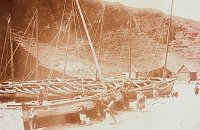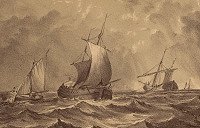Herring Home | Fishing for herring | Next
Early Scottish fishing boats

Scottish fishing boats of the 1700s and early 1800s were mainly small, open boats. They fished in inshore waters. These early boats were wooden and clinker-built, which means they were made with each plank overlapping the one below. They were all powered by sails, and most used lugsails. The boats were shallow, so that they could be used close to shore and they sat low in the water. However, they gave no shelter to the crew and were easily swamped in a storm. These early boats were usually family-owned, and were launched off beaches or from small harbours.

In the 18th century, the Government tried to encourage the use of the 'buss'. The herring busses were very large boats, of up to 80 tons with large crews. The Dutch has been fishing in the North Sea using this method since the 16th century. These boats fished in deeper water and stayed at sea for several weeks. The herring were caught using drift nets. The Dutch also perfected a method of preserving herring in salt, known as curing. They carried out the curing onboard their busses.
To encourage Scottish fishermen to fish using the 'buss', a bounty system was introduced. To start with, money was paid to fishermen who used boats over a certain size, but this law was soon changed so that money was paid on the amount of fish caught. This meant that fishermen fishing from small boats could also claim the bounty.
More fishermen began to catch herring, and they were able to buy new and bigger boats. Most ports along the East Coast had their own boatbuilder, and regional styles of fishing boats began to develop during the 19th century. The first of these were the skaffie and the fifie.